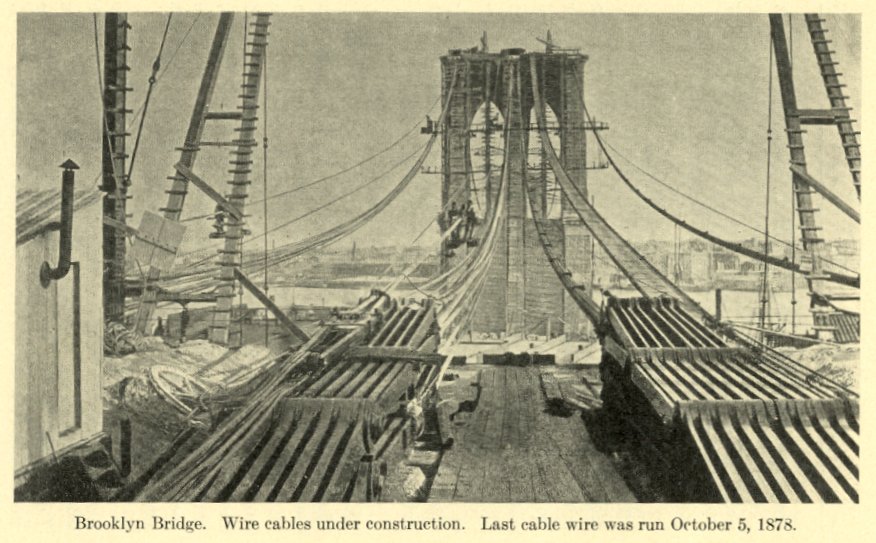
The details of constructing the Brooklyn Bridge towers have been performed under the eyes of all Brooklyn people. Since the tower of Babel and the great pyramid of Egypt, there has been no more massive structures. Block upon block the granite tiers were laid, until a total hieght of 278 feet above high water was attained. The New York tower is thus 356 feet high from the foundation. Further inland the equally ponderous anchorages were progressing, and although not so familiar because largely concealed by the surrounding buildings, are not the least important or least expensive details of the bridge. Still lower structures of solid masonry support the approaches.
In October 1878, a sensation was created by a communication to the N.Y. Sun, purporting to reveal a plot for blowing up the bridge. It was alleged that a certain stone-mason, inspired by the ambition of the “youth who fired the Ephesian Dome,” had secreted charges of dynamite between the courses of stone at the base of the tower on which he was engaged. The explosive was connected by wire with the exterior at points known only to the wicked mason, and at a suitable time, probably while the cities were celebrating the completion of the bridge, it was his intention to wreck the structure. A mysterious diagram was also published, said to be a copy of the working plan of the unprincipled wretch, showing the places of deposit and the line of connecting wires.
On May 29th 1877, a single wire was carried across the river attracting much attention as the first connecting link, with the “promise and potency” of greater things. The process of cable-making now commenced. Each cable is composed of 5,296 thicknesses of wire laid parallel. The wire is continuous in varying lengths, joined by a small screw coupling, which can never unscrew, the invention of Colonel Roebling and A.V. Abbot. At the anchorage the wire “returns” around a “shoe,” and so is carried from shore to shore until the cable is complete. It is then closely wrapped, forming a solid cylinder 15 3/4 inches in diameter. The total length of each cable is 3,578 feet, and it contains 3,589 miles of
wire.
Upon the four great cables thus composed, the suspended superstructure retains it’s inital and primary weight distribution. To avoid any lateral strain upon the towers, the cables are in no way fastended to them, but rest on movable “saddles” at the point of contact. These saddles, with their burdens, move to and fro upon 45 iron rollers of 3 1/2 inches diameter, which readily yield to the varying tention of the wires as the weight is shifted from the land to the river span, or vice versa.
A temporary structure called the “foot-bridge,” was thrown across the river during the cable-making, for the convenience of construction. It was much higher than the roadway of the permanent bridge, following the cables over the summits of the towers, instead of
passing through the arches. A trip across the foot-bridge on a clear, cool day, afforded an exciting and pleasurable novelty. The unaccustomed head would be dizzy, and both hands nervously clutch the wire hand-rails. Between the slats on which on walked were glimpses of gleaming water, and decks of toy ships and ferry boats with pigmy passengers. As our walk was but three feet wide, a ribbon through the air, it easily suggested a reminiscence of the narrow bridge Al Sirat, over which the people of Islam believe that the spirits of the departed must pass to paradise. The faithful tremble, but cross in safety, while unbelievers topple over into the fearful gulf. To avoid such thoughts, the traveler could look abroad and get distraction and delight from the wide panorama which the vicinity of New York affords.
How does the bridge look? is a question frequently asked. It’s external appearance from a distance is familiar from engravings which were exhibited everywhere before either one of the towers had reared its head above the tide. Some new ideas of details may perhaps be obtained from an imaginary trip to New York in July, 1883.
Descending from the horse car (or more happily the elevated railroad?) at the corner of Fulton and Sands streets, we notice no special change from the present aspect of Fulton street, but moving up Sands we find the southwestern corner of Washington street converted into the head of a busy thoroughfare, which closes abruptly at narrow Sands street; but the pressure there will soon be relieved, for a portion of the block bounded by Sands, Washington, High and Fulton has been taken as a public sqaure, that will be worthy the dignity of our bridge, and conduce to the convience of its traffic.

















 Photograph of the Williamsburg Bridge (1991)
Photograph of the Williamsburg Bridge (1991)


 Photograph of The Brooklyn Bridge at Night (1982)
Photograph of The Brooklyn Bridge at Night (1982)






